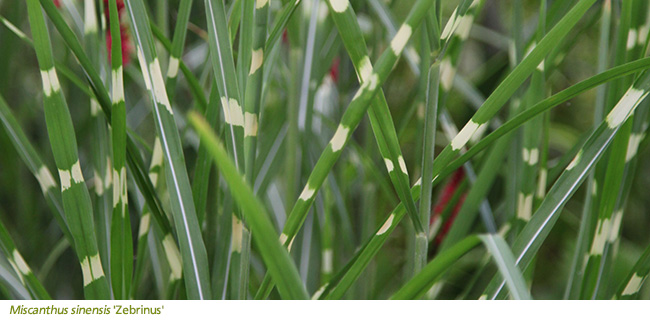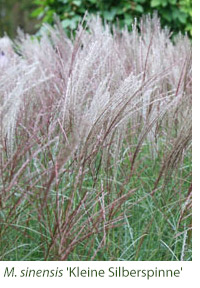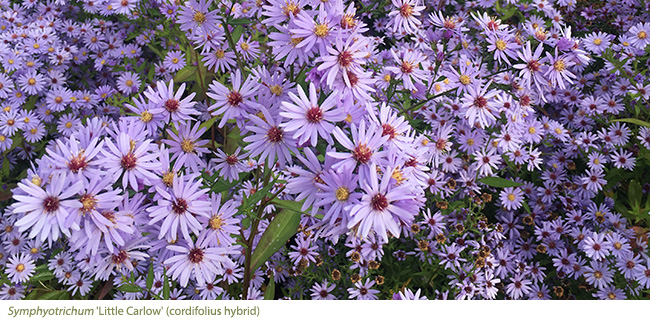Miscanthus - king of the autumn grasses
Late-season grasses come into their own from September adding another element or two - movement and texture to your garden. Most are tall and graceful and most move and sway with a gossamer presence. As autumn continues the texture of the awns, be it soft and fluffy or shiny and beaded, gets even more pronounced adding texture and form that lasts into winter.

Miscanthus sinensis stands supreme in the late-summer and autumn border, reaching somewhere between one and two metres,- the king of the autumn grasses. Some are grown for foliage alone and these include a subtle, yellow-banded, green-leaved miscanthus aptly named ‘Zebrinus’, or Zebra grass, because of its striped appearance. The stripes run across the leaf horizontally and are good at casting a light and shade pattern and this is precisely why Gertrude Jekyll (1843 - 1932) and William Robinson (1838- 1935) grew it under its old name of Eulalia japonica. A Japanese variety, that’s been around a long time, it rarely flowers but creates a good sheath of graceful, subtly banded foliage picking up the colour of tall yellow daisies, or acting as a foil for tall, late herbaceous.
 William Robinson also grew another miscanthus. from Japan, which we now know as ‘Morning Light’. This has fine, light green foliage vertically banded and margined in cream-white, giving it a soft appearance in the garden. It’s a neat grass that makes a narrow clump, so it’s one of the best for a smaller garden. It will flower in warm years, but the flowers (should they decide to appear) are late and spidery with little substance.
William Robinson also grew another miscanthus. from Japan, which we now know as ‘Morning Light’. This has fine, light green foliage vertically banded and margined in cream-white, giving it a soft appearance in the garden. It’s a neat grass that makes a narrow clump, so it’s one of the best for a smaller garden. It will flower in warm years, but the flowers (should they decide to appear) are late and spidery with little substance.
The craze for grasses took hold in Germany and their use was pioneered by a German landscape architect and nurseryman called Karl Foerster. He referred to grasses as nature’s hair and popularised them, but it was Ernst Pagels who began breeding them after working at Foerster’s nursery as a young man.

Miscanthus sinensis was difficult to succeed with in the cold climate of northern Germany, much more so than in Britain, so Pagels set himself the task of raising earlier flowering ones that would perform. He persuaded ‘Gracillimus’, a refined miscanthus with a fountain of fine foliage that underpins airy flowers, to flower much earlier by growing it under glass. He collected and grew the seeds on. ‘Gracillimus’ was an inspired choice because this miscanthus develops a golden aura which flatters the thickly textured beige tassels.
 Pagels, who deliberately selected earlier flowering plants, produced some stunners. ‘Maleparetus’ is very similar to ‘Gracillimus’, but it will produce awns up to a month earlier. The finely banded foliage is topped with maroon-red upright awns by late summer. These age to pink, etched with silver. ‘Kleine Silberspinne’ (literally little silver spider) and ‘Kleine Fontäne’ (little fountain) were both bred by him. Both reach 1.5m and ‘Kleine Silberspinne’ has needle-like foliage and fine cockades in pink-red. ‘Kleine Fontäne’ is named because it produces a succession of slender, upright, red-toned silver flowers over several weeks. These red flowers, which look at their best in September light, quickly fade to snuff-brown and then to silver and gold.
Pagels, who deliberately selected earlier flowering plants, produced some stunners. ‘Maleparetus’ is very similar to ‘Gracillimus’, but it will produce awns up to a month earlier. The finely banded foliage is topped with maroon-red upright awns by late summer. These age to pink, etched with silver. ‘Kleine Silberspinne’ (literally little silver spider) and ‘Kleine Fontäne’ (little fountain) were both bred by him. Both reach 1.5m and ‘Kleine Silberspinne’ has needle-like foliage and fine cockades in pink-red. ‘Kleine Fontäne’ is named because it produces a succession of slender, upright, red-toned silver flowers over several weeks. These red flowers, which look at their best in September light, quickly fade to snuff-brown and then to silver and gold.
Miscanthus make tight clumps and start into growth early on, and the easiest way to ensure a fresh stand of foliage is to cut them back hard in February so that they start all over again. Some gardeners use tulips amongst miscanthus because by the time the tulips flower in April and May, the foliage has developed into a lush, bright green mound.

All taller grasses need equally tall perennials as partners to avoid the ‘Little and Large’ look, so the flowering ones, often called Prince of Wales feathers, associate well with taller perennials such as Veronicastrums, Sanguisorba ‘Red Thunder’, Helianthus ‘Lemon Queen', Symphyotrichum 'Little Carlow'. This type of combination, tall grasses and late-season perennials, will often have winter presence for many months before they are cut back in February.








